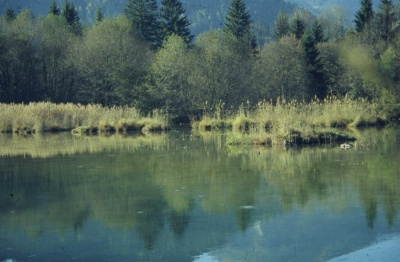Adjust land use to reduce nutrient, sediment input or shore erosion
Contents
- 1 General description
- 2 Applicability
- 3 Expected effect of measure on (including literature citations)
- 4 Temporal and spatial response
- 5 Pressures that can be addressed by this measure
- 6 Cost-efficiency
- 7 Case studies where this measure has been applied
- 8 Useful references
- 9 Other relevant information
General description
The alteration of river catchments mostly implies deforestation, techniques to improve drainage of wet areas, soil amelioration techniques and the planting of crops or the introduction of domestic grazers. These changes in land use can lead to erosion, nutrient increase, and increased runoff of pollutants from surrounding areas (Bouwman et al. 2005). In rivers where bed-forming processes are impaired, undesired fine sediment input can degrade riverbed habitats by infiltrating and clogging the surface of the riverbed (Ayres et al. 2014). Catchment reforestation, extensification of land use and buffer strip maintenance are effective measures to reduce undesired sediment or nutrient inputs and should be established in combination with the restoration of the flow regimes that govern erosion and sedimentation within the river channel (Greig et al. 2005). Reforestation is a human-induced land use change in which trees are planted on previously non forested areas. Semi-natural areas other than forests may be afforested for improvements in water retention and hydrological cycling (Raftoyannis et al. 2011).
This land use conversion has the potential to substantially increase landscape-scale runoff storage. Afforestation can increase runoff storage in several ways. The higher rates of evapotranspiration associated with growing forests can dry out soils, providing more infiltration and storage capacity for precipitation. Forests, with their relatively high rates of litter-fall, provide additional organic carbon to the soil, which can improve soil structure, leading to both higher water holding capacity and greater infiltration capacity (Raftoyannis et al. 2011).
Pasture and meadow management can reduce erosion and sediment delivery by ensuring greater vegetation coverage which reduces surface flow and availability of sediments (Parkyn et al. 2003).
Applicability
Afforestation and reforestation are two forms of direct human-induced conversions of non-forest to forest land through planting, seeding, and/or anthropogenic dispersal of natural seed sources. Land use conversion through afforestation have benefits at all spatial scales. The smallest realistic conversion is probably the individual field, while the largest could be a whole catchment (Raftoyannis et al. 2011). Holistic catchment management should be adopted in accordance with reach-scale restoration measures to manage fine sediment and nutrient input (Owens et al. 2005).
Expected effect of measure on (including literature citations)
There are significant relationships between catchment land use, water nutrient concentrations and stream taxon diversity (Weijters et al. 2009). The trees in riparian and adjacent areas of rivers can efficiently take up excess nutrients and may also serve to increase infiltration and decrease sediment inputs to surface waters. Many of the factors that contribute to diverse ecological improvements may only be achieved over long time scales. Rehabiliation of temperature regime and shade and the structure and habitat function of woody debris in streams may take decades to develop (Parkyn et al. 2003).
| Category | Description | Source (citation) |
| Hydromorphology | ||
| Macrophytes | ||
| Macroinvertebrats | Loss of native macroinvertebrate species due to intensive land use cover | Weijters et al. 2009 |
| Fish | Loss of native fish species due to intensive land use cover | Weijters et al. 2009 |
Temporal and spatial response
Not available.
Pressures that can be addressed by this measure
Cost-efficiency
Not available.
Case studies where this measure has been applied
- Asseltse Plassen - Bank erosion
- Carrión
- Negro
- Regge Velderberg
- Rijkelse Bemden - River bed widening
- Narew river restoration project
- Tajo. Improvement of ecological state of the Tajo and tributaries riverside affected by the spill of kaolin, at Poveda de la Sierra and Taravilla (Guadalajara)
- Skjern - LIFE project
- River Wensum Rehabilitation Project - Bintree
- Bakenhof - Dyke relocation
- Conservation of Atlantic Salmon in Scotland (LIFE 04/NAT/GB/000250)
- Lippeaue Klostermersch
Useful references
- Ayres, A., H. Gerdes, B. Goeller, M. Lago, M. Catalinas, Á. García Cantón, R. Brouwer, O. Sheremet, J. Vermaat, N. Angelopoulos, and I. Cowx (2014). Inventory of restoration costs and benefits. REFORM Deliverable 1.4.
- Bouwman, A.F., G. Van Drecht, J. M. Knoop, A. H. W. Beusen, and C. R. Meinardi (2005). Exploring changes in river nitrogen export to world`s oceans. Global Biogeochemical Cycles, 19, 1-14.
- Greig, S. M., D. A. Sear, and P. A. Carling (2005). The impact of fine sediment accumulation on the survival of incubating salmon progeny: implications for sediment management. Science of the Total Environment, 344, 241-258.
- Owens, P.N., R. J. Batalla, A. J. Collins, B. Gomez, D. M. Hicks, A. J. Horowitz, G. M. Kondolf, M. Marden, M. J. Page, D. H. Peacock, E. L. Petticrew, W. Salomons, and N. A. Trustrum (2005). Fine-grained sediment in river systems: Environmental significance and management issues. River Research and Applications, 21, 693-717.
- Parkyn, S. M., R. J. Davies-Colley, N. J. Halliday, K. J. Costley, and G. F. Croker (2003). Planted riparian buffer zones in New Zealand: do they live up to expectations? Restoration Ecology, 11, 436–447.
- Raftoyannis, Y., Y. Raftoyannis, M. Bredemeier, R. Buozyte, N. Lamersdorf, A. Mavrogiakoumos, E. Oddsdóttir, and I. Velichkov (2011). Afforestation Strategies with Respect to Forest–Water Interactions. Forest Management and the Water Cycle: An Ecosystem-Based Approach. Ecological Studies, Springer Netherlands, 212, 225-245.
- Weijters, M. J., J. H. Janse, R. Alkemade, and J. T. A. Verhoeven (2009). Quantifying the effect of catchment land use and water nutrient concentrations on freshwater river and stream biodiversity. Aquatic Conservation: Marine and Freshwater Ecosystems, 19, 104-112.
